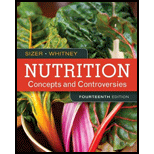
Nutrition: Concepts and Controversies - Standalone book (MindTap Course List)
14th Edition
ISBN: 9781305627994
Author: Frances Sizer, Ellie Whitney
Publisher: Brooks Cole
expand_more
expand_more
format_list_bulleted
Concept explainers
Question
Chapter 3, Problem 16SC
Summary Introduction
Introduction:
Body needs certain essential nutrients such as vitamins, minerals, proteins, and fats. All these nutrients play specific functions in the body. Fats are stored in the body for later use. Body use glucose as source of energy but during a period of fasting the body use these fats as a source of energy to maintain different cellular activities, as the body is deprived of glucose.
Expert Solution & Answer
Trending nowThis is a popular solution!

Chapter 3 Solutions
Nutrition: Concepts and Controversies - Standalone book (MindTap Course List)
Ch. 3 - Moderate alcohol use has been credited with...Ch. 3 - Your daughter is leaving for college in the fall....Ch. 3 - Cells a. are self-contained, living units. b....Ch. 3 - Each gene is a blueprint that directs the...Ch. 3 - Prob. 3SCCh. 3 - Prob. 4SCCh. 3 - Hormones a. are rarely involved in disease...Ch. 3 - Prob. 6SCCh. 3 - Prob. 7SCCh. 3 - Prob. 8SC
Knowledge Booster
Learn more about
Need a deep-dive on the concept behind this application? Look no further. Learn more about this topic, health-nutrition and related others by exploring similar questions and additional content below.Similar questions
- After you eat too many carbohydrates and proteins, your body converts the excess to storage fats, which accumulate in.____________. a. loose connective tissue b. . dense connective tissue c. adipose tissue d. both b and carrow_forwardWhich of the following statements is not true? a. Essential nutrients can be synthesized by the body. b. Vitamins are required in small quantities for bodily function. c. Some amino acids can be synthesized by the body, while others need to be obtained from diet. d. Vitamins come in two categories: fat-soluble and water-soluble.arrow_forwardBile has a role in _________ digestion and absorption. a. carbohydrate c. protein b. fat d. amino acidarrow_forward
- The preferred energy sources for the body are ________.arrow_forwardSome nutritionists claim that the secret to long life is to be slightly underweight as an adult. If a persons weight is related partly to diet, partly to activity level, and partly to genetics, what underlying factors could be at work to generate statistics that support this claim?arrow_forwardBasal metabolic rate is a measure of ______. a. the total amount of calories you burn in 24 hours b. the amount of food energy needed to sustain basic body operations c. the amount of energy burned by skeletal muscle in a given period d. both a and barrow_forward
- When faced with a sudden drop in environmental temperature, an endothermic animal will _______. a. experience a drop in its body temperature b. wait to see if it goes lower c. increase muscle activity to generate heat d. add fur or fat to increase insulationarrow_forwardATP for muscle contraction can be provided by ______. a. aerobic respiration b. lactate fermentation c. transfer of a phosphate from creatine phosphate d. all of the abovearrow_forward
arrow_back_ios
arrow_forward_ios
Recommended textbooks for you
 Human Biology (MindTap Course List)BiologyISBN:9781305112100Author:Cecie Starr, Beverly McMillanPublisher:Cengage Learning
Human Biology (MindTap Course List)BiologyISBN:9781305112100Author:Cecie Starr, Beverly McMillanPublisher:Cengage Learning

Human Biology (MindTap Course List)
Biology
ISBN:9781305112100
Author:Cecie Starr, Beverly McMillan
Publisher:Cengage Learning




